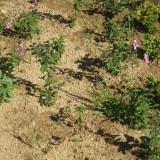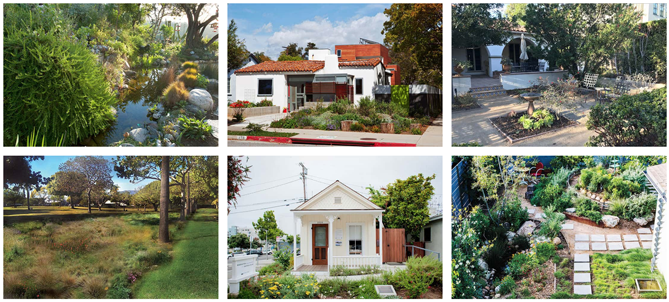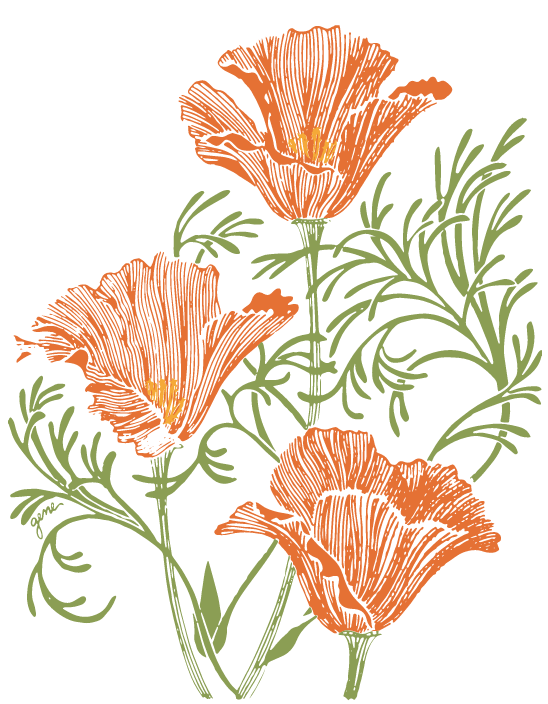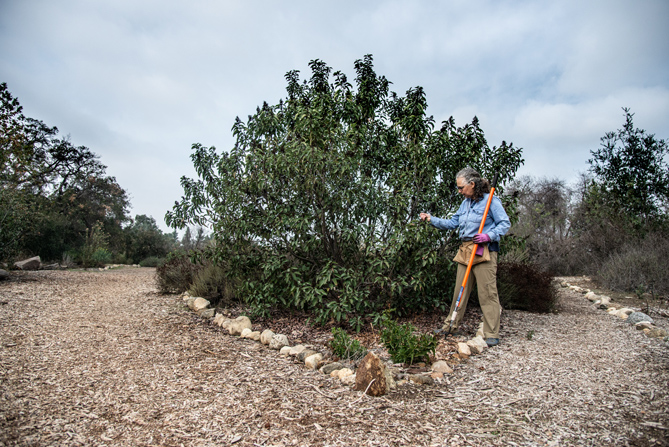
A beautiful stand of big old manzanitas, photo taken last March after an alarmingly dry winter. They don’t need your water, thank you very much.
Recently I was fortunate enough to attend a class called Watershed Wise Landscape Training, taught by the fantastic Pamela Berstler of G3 (Green Gardens Group), hosted in the lovely TreePeople facility, and offered at a low price thanks to the LADWP. For two days I had my mind blown with water math and plant facts, and I wanted to share this story with you. I call it the Manzanita Miracle.
We learned how to calculate how much water plants need, and how often you need to water them. It’s not easy–but it is possible. This really is like the holy grail to a gardener who has been guessing about watering all her life.
For practice, we ran the calculations for a manzanita. Manzanitas (Arctostaphylos) are handsome native California plants–native to the West in general– known especially for their glossy red bark and twisting limbs. They appear as both ground cover and shrubs, and some of the happier shrubs can get big enough to resemble small trees.
As a class we ran the calculations needed to figure out how much water a particular manzanita would need in a particular place. These calculations are never general–they are always very specific to plant, soil and place. I’m not going to go through the math here—for this post specifics of the calculations are not as important here as the results.
The manzanita in question was a three year old plant with a 36″ root depth. Root depth is not guessed, but measured by using a soil probe. Manzanitas are categorized a low water use plants. The location was in Los Angeles, and the soil type was a sandy clay.
Using this information, we were able to calculate how much water the soil held, and how much the plant used daily, leading us to figure out how long this particular plant can go between waterings–safely. Not pushing it to the edge of death, you understand, just calculating its normal water needs. This figure is called the “irrigation interval” and the answer was 225 days.
Let me repeat that. This particular plant expects to go 225 consecutive days without water every year, and can do so without stress.
And this number is just based on the evapotranspiration rate of the plant. It doesn’t account for healthy soil biology. A thriving population of fungi and bacteria around the plant’s root zone might make it even more resilient–that is, able to last longer without water.
But anyway, 225 days translates to about 7 months between waterings–which just so happens to be a reflection of our annual dry season in Southern California.
And when that watering deadline rolls around, how much water does this particular manzanita need to recharge its water reserves?
4 inches.
Even in our desperate drought, we’re getting that much rain annually.
The moral here is that nature has provided us with everything we need. We have beautiful native plants which can thrive with no supplemental water whatsoever, even in drought, provided we plant them correctly, and treat them well. (That last part is actually a huge caveat, since we don’t do either very often.)
Here in Los Angeles we seem to be trapped between two competing and unhealthy ideologies. One is “You’ll pry my lawn out of my cold dead hands” and the other is “Los Angeles is a desert, so I’m planting cactus.”
Neither is appropriate. In Los Angeles, a lawn needs about 50 inches of water a year to stay green–and it usually gets twice that much–up to 100 inches. Compare that to manzanita’s 4 inches.
Cactus doesn’t need much water, true, but we are not a desert–yet. We are in the process of desertification, yes, which is not a good thing. At the end of this road, we don’t end up in a dreamy Georgia O’Keefe style desert, we just end up in a hot, polluted city surrounded by a dead landscape. Gravel and cactus landscapes simply hurry this process along, because they don’t cool the city, and they don’t build soil which can capture and hold water.
We need to settle down in a comfortable in-between spot. This is not Ireland and this is not Sonora. This is Southern California and we have a whole palette of amazing, largely misunderstood plants which are ready willing and able to green this place up even in the heart of a drought.
All we have to do is treat these plants right. Native plants have a reputation for being tricky, and it’s true, in that they don’t act like typical imported landscape plants–the lawns and the boxwood hedges. They don’t need even a fraction of the water as exotics do, so they are almost always overwatered, and die as a result.
I think it is hard for us to even imagine that plants can be so profoundly unthirsty, because we are so accustomed to babying along lawns and other needy plants. We might water our hypothetical manzanitas every two to three weeks, thinking that is what “low water use plant” means. The math shows us how wrong that is–and why manzanitas often die in home landscapes.
Imagine a yard which doesn’t need water at all, even in a drought year. Imagine yourself, free from the chore of watering, free to just not worry about it, because the plants are taking care of themselves. Wouldn’t that make it worth the trouble to learn how to host native plants?
225 days.





Lovely, inspiring post.
Any educational resources available for purchase?
Yes yes yes!
Now, I want to know the exact water needs for ALL the plants I tend to like in my garden: Ceonothus? Toyon? etc. I would like to buy a book about this!
A brilliant reminder that the plants that grow locally, tend to be best suited to your climate and will withstand the difficulties that your local conditions throw at them.
I would never have imagined this would have been such a precise science for specific plants in a specific location. I wish I had known this when I let my pink dogwoods die! They were over fifty-years old and my ignorance robbed my life of beauty. Where can we get this information for our own plants?
Amazing post and so well written. Gives me lots to think about.
I just can’t imagine why, when given the choice to raise native or foreign plants, you would pick foreign ones. You’re just asking for extra work and trouble when you choose something that isn’t native!